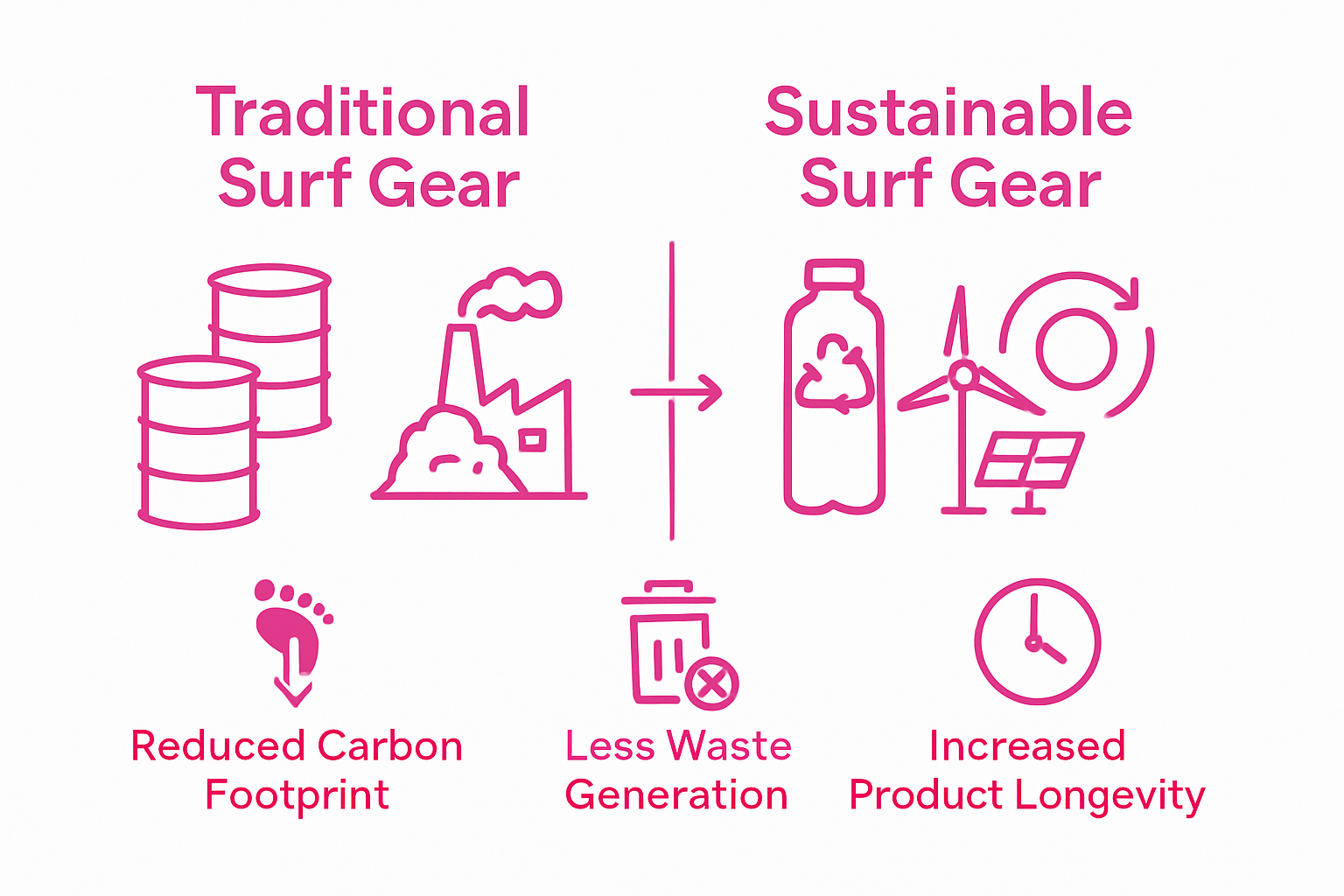Sustainable surf gear is changing the way people think about water sports equipment. Most surfers do not realize that some wetsuit brands are now using reclaimed ocean plastics and bio-based neoprene, which slashes environmental impact. What surprises many is that this gear often outperforms traditional products thanks to advanced material science breakthroughs.
Table of Contents
- What Is Sustainable Surf Gear?
- Why Is Sustainable Surf Gear Important?
- How Does Sustainable Surf Gear Work?
- Key Concepts Of Sustainable Surf Gear
- The Future Of Sustainable Surf Gear In Watersports
Quick Summary
| Takeaway | Explanation |
|---|---|
| Choose recycled or renewable materials | Opting for gear made from recycled ocean plastics or bio-based materials reduces waste and environmental impact. |
| Focus on product longevity and repairability | Gear designed for extended use and easy repairs minimizes waste and promotes sustainability. |
| Support the circular economy principles | Look for products that prioritize reusability, recycling, and responsible disposal to conserve resources. |
| Engage in eco-conscious consumerism | As a surfer, select sustainable gear to support marine ecosystem protection and foster environmental stewardship. |
| Embrace innovative sustainable technologies | Stay informed about advancements in biodegradable materials and smart textiles that enhance performance with minimal ecological impact. |
What is Sustainable Surf Gear?
Sustainable surf gear represents an innovative approach to creating water sports equipment that minimizes environmental impact while maintaining high performance standards. At its core, this concept goes beyond traditional manufacturing by prioritizing ecological responsibility throughout the entire product lifecycle.
To help clarify the distinctions and connections between traditional surf gear and sustainable surf gear, the following table compares their key features and environmental impact factors.
| Aspect | Traditional Surf Gear | Sustainable Surf Gear |
|---|---|---|
| Materials Used | Petroleum-based neoprene, virgin plastics | Reclaimed ocean plastics, bio-based neoprene |
| Manufacturing Process | High carbon emissions and waste | Energy-efficient, low-emission processes |
| Product Longevity | Often limited, not designed for repair | Extended lifespan, repairable design |
| End-of-Life Disposal | Usually landfilled, non-biodegradable | Focused on recyclability, responsible disposal |
| Ecological Impact | Contributes to marine and landfill waste | Minimizes waste, protects marine ecosystems |
| Consumer Focus | Performance-oriented | Performance and ecological responsibility |
The Core Components of Sustainable Surf Gear
Sustainable surf gear involves multiple critical considerations that transform how equipment is designed, produced, and ultimately consumed. The primary focus is on reducing environmental footprint through conscious material selection, manufacturing processes, and product lifecycle management.
This table outlines the core components of sustainable surf gear, summarizing their characteristics and how they contribute to environmental stewardship and product performance.
| Component | Characteristic | Environmental Benefit |
|---|---|---|
| Recycled/Renewable Materials | Made from reclaimed ocean plastics, bio-based neoprene | Reduces resource extraction and waste |
| Eco-Friendly Manufacturing | Uses processes that lower emissions and waste | Shrinks carbon footprint |
| Product Longevity | Designed for durability and easy repair | Minimizes replacement and landfill |
| Responsible Disposal | Focus on recycling and biodegradability | Prevents pollution and conserves resources |
| Circular Economy Principles | Emphasizes reuse, repair, and recycling | Keeps materials in usage cycle |
Key Components Include:
- Use of recycled or renewable materials like reclaimed ocean plastics, bio-based neoprene, and responsibly sourced natural fibers
- Manufacturing processes that minimize carbon emissions and waste generation
- Products designed for longevity, repairability, and eventual responsible disposal
Environmental Impact and Surfer Responsibility
Surfers have a unique relationship with the ocean, making them natural environmental stewards. Research from the University of Wollongong highlights how the surfing community is increasingly recognizing its role in promoting sustainability. By choosing sustainable surf gear, athletes actively participate in protecting marine ecosystems.
Beyond materials, sustainable surf gear encompasses a holistic approach that considers the entire product journey. This means evaluating everything from raw material extraction to manufacturing energy consumption, transportation emissions, and eventual product disposal or recycling.
For those interested in exploring high-quality sustainable equipment solutions, check out our heavy-duty wetsuit hanger designed with biodegradable materials and environmental consciousness in mind.
Why is Sustainable Surf Gear Important?
Sustainable surf gear transcends mere environmental consciousness.
 It represents a critical strategy for protecting marine ecosystems, reducing industrial waste, and preserving the long-term viability of water sports while minimizing ecological impact.
It represents a critical strategy for protecting marine ecosystems, reducing industrial waste, and preserving the long-term viability of water sports while minimizing ecological impact.
Environmental Conservation and Resource Management
The surfing industry has traditionally been resource-intensive, with significant carbon footprints generated through manufacturing processes, material sourcing, and product transportation. Research from Stanford University indicates that nature-based recreational activities like surfing require comprehensive environmental management strategies to mitigate potential ecological damage.
Critical Environmental Benefits Include:
- Reduction of non-biodegradable waste in marine environments
- Decreased carbon emissions during production processes
- Conservation of natural resources through circular design principles
- Minimization of chemical pollution in manufacturing
Economic and Industry Transformation
Sustainable surf gear drives broader industry transformation by creating economic incentives for environmentally responsible practices. Manufacturers who invest in sustainable technologies not only reduce environmental impact but also appeal to increasingly eco-conscious consumers who prioritize ethical purchasing decisions.
Moreover, sustainable practices encourage innovation in material science, leading to advanced equipment that performs exceptionally while maintaining minimal environmental footprint. This approach challenges traditional manufacturing paradigms and promotes technological advancement.
For water sports enthusiasts interested in supporting sustainable solutions, explore our latest wetsuit hanger collection designed with environmental responsibility in mind. Our products demonstrate how sustainability and high-performance equipment can coexist harmoniously.
How Does Sustainable Surf Gear Work?
Sustainable surf gear operates through a comprehensive approach that reimagines traditional manufacturing processes, material selection, and product design to minimize environmental impact while maintaining superior performance standards.
Material Innovation and Sourcing
The fundamental mechanism of sustainable surf gear involves revolutionary material transformation. Manufacturers now utilize cutting-edge technologies to convert waste materials into high-performance equipment. Research from the University of California demonstrates how innovative techniques like transforming algae into surfboard materials represent a breakthrough in sustainable manufacturing.
Key Material Transformation Strategies:
- Recycling ocean plastics into durable gear components
- Developing bio-based neoprene from sustainable sources
- Utilizing renewable materials with minimal environmental processing
- Implementing closed-loop manufacturing systems
Performance and Lifecycle Engineering
Sustainable surf gear is engineered to deliver exceptional performance while prioritizing long-term environmental considerations. This approach involves designing products that are not only technologically advanced but also designed for extended use, easy repair, and eventual responsible disposal.
The engineering process focuses on creating gear that reduces waste through:
- Modular design allowing component replacement
- Enhanced durability to extend product lifespan
- Materials selected for minimal environmental degradation
- Manufacturing processes that minimize carbon emissions
For water sports enthusiasts wanting to stay updated on sustainable innovations, check out our latest news and developments in eco-friendly surf equipment technology. Our commitment extends beyond product creation to continuous research and improvement in sustainable manufacturing practices.
Key Concepts of Sustainable Surf Gear
Sustainable surf gear encompasses a holistic approach that integrates environmental responsibility, technological innovation, and ethical manufacturing practices throughout the entire product lifecycle. Understanding these foundational principles is crucial for both manufacturers and consumers committed to reducing ecological impact.
Circular Economy and Material Lifecycle
The circular economy model represents a fundamental concept in sustainable surf gear development. Research from the Sustainable Surf Project demonstrates how this approach transforms traditional linear manufacturing into a regenerative system where materials are continuously reused, recycled, and repurposed.
Core Circular Economy Principles:
- Designing products for maximum longevity and repairability
- Creating closed-loop manufacturing systems
- Minimizing waste through innovative recycling techniques
- Prioritizing renewable and recyclable material sources
Ecological Performance Metrics
Sustainable surf gear is evaluated not just on performance characteristics but also on its comprehensive environmental impact. This holistic assessment considers multiple factors beyond traditional product evaluation metrics.
Key Performance Evaluation Criteria:
- Carbon footprint during production
- Energy consumption in manufacturing
- Water usage and potential pollution
- Biodegradability of materials
- Long-term environmental degradation potential
For water sports enthusiasts passionate about understanding sustainable innovations, our latest news section provides ongoing insights into emerging technologies and practices in eco-friendly surf equipment development. Our commitment extends beyond product creation to fostering a deeper understanding of sustainable manufacturing principles.
The Future of Sustainable Surf Gear in Watersports
The evolution of sustainable surf gear represents a critical intersection between technological innovation, environmental stewardship, and the global watersports community’s commitment to ocean preservation. As climate challenges intensify, the watersports industry stands at the forefront of transformative ecological practices.
Technological Disruption and Material Innovation
Advanced material science is driving unprecedented changes in sustainable surf gear development. Research from UNESCO indicates that emerging technologies are revolutionizing how watersports equipment is conceptualized, designed, and manufactured.
Emerging Technological Frontiers Include:
- Biodegradable synthetic materials derived from organic sources
- Nanotechnology enabling enhanced material performance
- Smart fabrics with embedded environmental tracking capabilities
- Self-repairing material technologies
Collaborative Ecosystem and Industry Transformation
The future of sustainable surf gear transcends individual product development. It demands a comprehensive, collaborative approach involving manufacturers, environmental scientists, professional athletes, and consumers working together to reimagine watersports equipment.
Key Collaborative Strategies:
- Establishing industry-wide sustainability certification standards
- Creating transparent supply chain practices
- Investing in research and development of eco-friendly materials
- Promoting consumer education about sustainable gear choices
For enthusiasts eager to stay informed about cutting-edge developments, explore our latest news and innovations in sustainable watersports technology. Our commitment extends beyond product creation to fostering a global community dedicated to ocean conservation and technological advancement.

Bring Sustainable Surf Practices Into Your Everyday Gear Care
Are you ready to put your commitment to sustainability into action? This article reveals the urgent need for eco-friendly surf gear and highlights the environmental impact of traditional equipment. One clear challenge stands out: even the way you care for your wetsuit can make a difference. Many surfers worry about product longevity and waste. The right storage choice solves these pain points and extends the life of your gear while also protecting the planet.
Explore our sustainable wetsuit hangers designed specifically for environmentally conscious surfers. Our heavy duty hangers can hold up to 15kg, are foldable for easy use, and feature wide shoulders to protect your wetsuit’s neoprene while speeding up drying time. Each hanger is 3D printed with biodegradable PLA+ plastic, perfectly aligning with the sustainable concepts discussed in the article.

Don’t just read about making a difference—take a real step toward ocean-friendly surf habits. Visit Surf Vida now to shop our collection and see how simple it can be to support a cleaner future every time you hang up your wetsuit.
Frequently Asked Questions
What is sustainable surf gear?
Sustainable surf gear refers to water sports equipment designed to minimize environmental impact through the use of eco-friendly materials and responsible manufacturing processes.
Why is sustainable surf gear important for surfers?
Sustainable surf gear is essential as it helps protect marine ecosystems, reduces waste, and supports the long-term viability of water sports by minimizing ecological harm.
How does the material selection process for sustainable surf gear work?
Sustainable surf gear utilizes recycled, renewable materials, and innovative technologies that convert waste into high-performance equipment, adhering to standards that reduce environmental impact.
What benefits does the circular economy model provide in the context of sustainable surf gear?
The circular economy model emphasizes reusability and recycling, ensuring that materials are continuously repurposed, which reduces waste, conserves resources, and fosters environmental responsibility.

